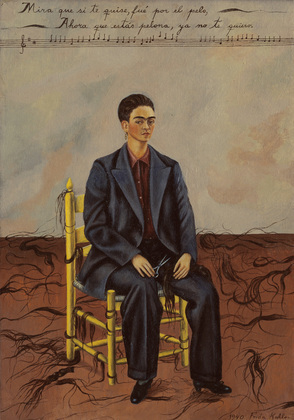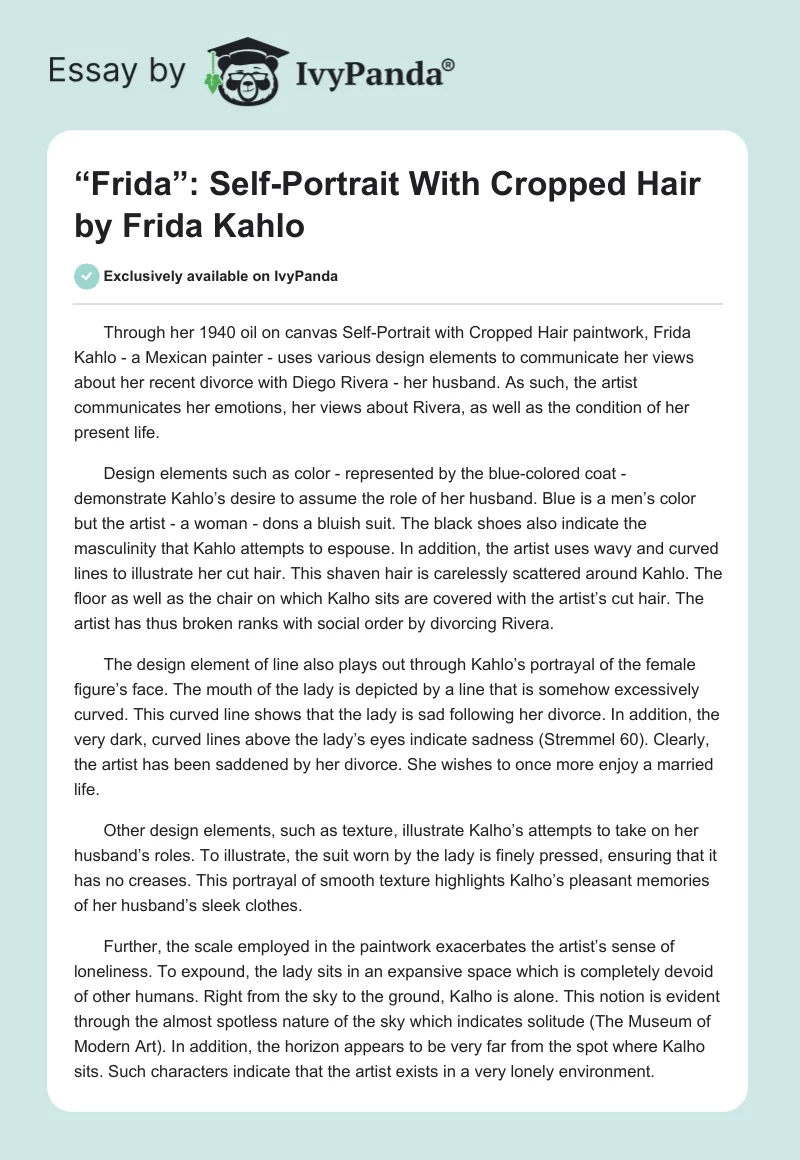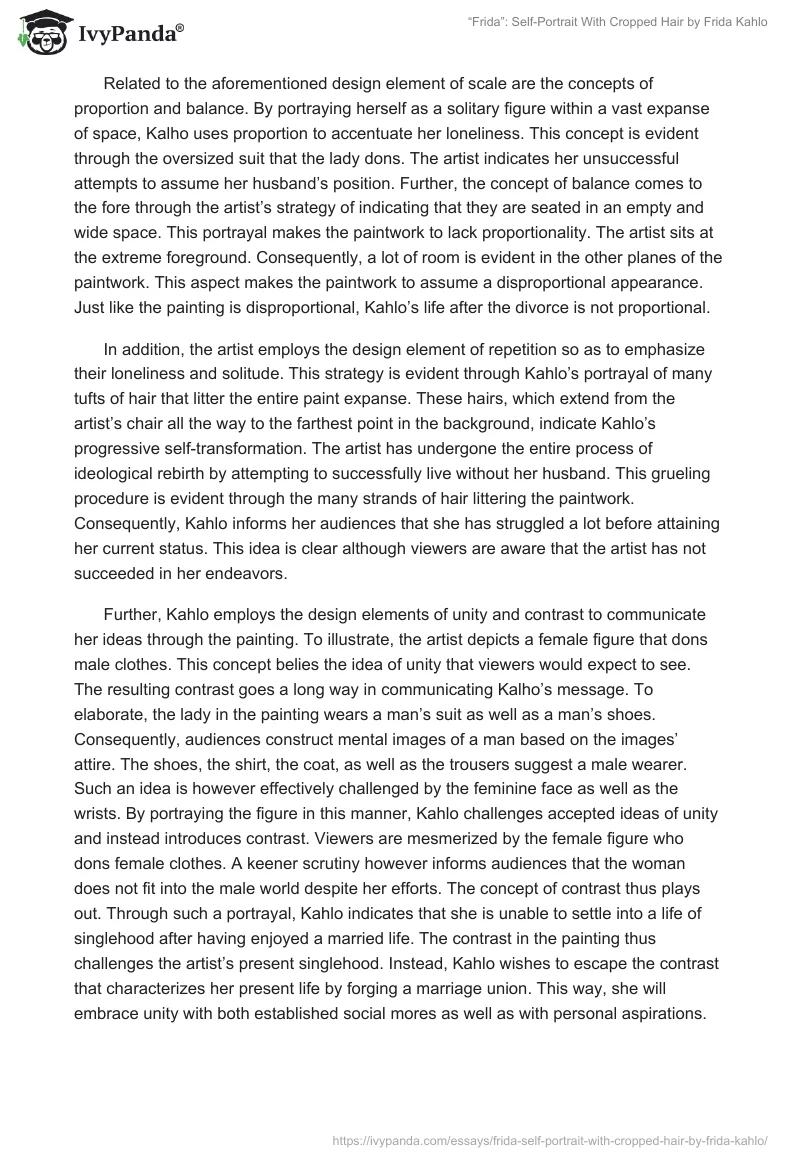Through her 1940 oil on canvas Self-Portrait with Cropped Hair paintwork, Frida Kahlo – a Mexican painter – uses various design elements to communicate her views about her recent divorce with Diego Rivera – her husband. As such, the artist communicates her emotions, her views about Rivera, as well as the condition of her present life.
Design elements such as color – represented by the blue-colored coat – demonstrate Kahlo’s desire to assume the role of her husband. Blue is a men’s color but the artist – a woman – dons a bluish suit. The black shoes also indicate the masculinity that Kahlo attempts to espouse. In addition, the artist uses wavy and curved lines to illustrate her cut hair. This shaven hair is carelessly scattered around Kahlo. The floor as well as the chair on which Kalho sits are covered with the artist’s cut hair. The artist has thus broken ranks with social order by divorcing Rivera.
The design element of line also plays out through Kahlo’s portrayal of the female figure’s face. The mouth of the lady is depicted by a line that is somehow excessively curved. This curved line shows that the lady is sad following her divorce. In addition, the very dark, curved lines above the lady’s eyes indicate sadness (Stremmel 60). Clearly, the artist has been saddened by her divorce. She wishes to once more enjoy a married life.
Other design elements, such as texture, illustrate Kalho’s attempts to take on her husband’s roles. To illustrate, the suit worn by the lady is finely pressed, ensuring that it has no creases. This portrayal of smooth texture highlights Kalho’s pleasant memories of her husband’s sleek clothes.
Further, the scale employed in the paintwork exacerbates the artist’s sense of loneliness. To expound, the lady sits in an expansive space which is completely devoid of other humans. Right from the sky to the ground, Kalho is alone. This notion is evident through the almost spotless nature of the sky which indicates solitude (The Museum of Modern Art). In addition, the horizon appears to be very far from the spot where Kalho sits. Such characters indicate that the artist exists in a very lonely environment.
Related to the aforementioned design element of scale are the concepts of proportion and balance. By portraying herself as a solitary figure within a vast expanse of space, Kalho uses proportion to accentuate her loneliness. This concept is evident through the oversized suit that the lady dons. The artist indicates her unsuccessful attempts to assume her husband’s position. Further, the concept of balance comes to the fore through the artist’s strategy of indicating that they are seated in an empty and wide space. This portrayal makes the paintwork to lack proportionality. The artist sits at the extreme foreground. Consequently, a lot of room is evident in the other planes of the paintwork. This aspect makes the paintwork to assume a disproportional appearance. Just like the painting is disproportional, Kahlo’s life after the divorce is not proportional.
In addition, the artist employs the design element of repetition so as to emphasize their loneliness and solitude. This strategy is evident through Kahlo’s portrayal of many tufts of hair that litter the entire paint expanse. These hairs, which extend from the artist’s chair all the way to the farthest point in the background, indicate Kahlo’s progressive self-transformation. The artist has undergone the entire process of ideological rebirth by attempting to successfully live without her husband. This grueling procedure is evident through the many strands of hair littering the paintwork. Consequently, Kahlo informs her audiences that she has struggled a lot before attaining her current status. This idea is clear although viewers are aware that the artist has not succeeded in her endeavors.
Further, Kahlo employs the design elements of unity and contrast to communicate her ideas through the painting. To illustrate, the artist depicts a female figure that dons male clothes. This concept belies the idea of unity that viewers would expect to see. The resulting contrast goes a long way in communicating Kalho’s message. To elaborate, the lady in the painting wears a man’s suit as well as a man’s shoes. Consequently, audiences construct mental images of a man based on the images’ attire. The shoes, the shirt, the coat, as well as the trousers suggest a male wearer. Such an idea is however effectively challenged by the feminine face as well as the wrists. By portraying the figure in this manner, Kahlo challenges accepted ideas of unity and instead introduces contrast. Viewers are mesmerized by the female figure who dons female clothes. A keener scrutiny however informs audiences that the woman does not fit into the male world despite her efforts. The concept of contrast thus plays out. Through such a portrayal, Kahlo indicates that she is unable to settle into a life of singlehood after having enjoyed a married life. The contrast in the painting thus challenges the artist’s present singlehood. Instead, Kahlo wishes to escape the contrast that characterizes her present life by forging a marriage union. This way, she will embrace unity with both established social mores as well as with personal aspirations.
Works Cited
Stremmel, Kerstin. Realism. Koeln, Germany: Taschen, 2004. Print.
“The Museum of Modern Art.” MOMA | The Collection| Frida Kahlo, Self-Portrait with Cropped Hair, 1940.
Appendix



